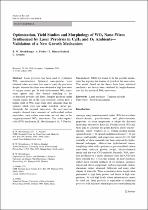 ResearchSpace
ResearchSpace
Optimization, yield studies and morphology of WO3 nano-wires synthesized by laser pyrolysis in C2H2 and O2 ambients—validation of a new growth mechanism
JavaScript is disabled for your browser. Some features of this site may not work without it.
- ResearchSpace
- →
- Research Publications/Outputs
- →
- Journal Articles
- →
- View Item
| dc.contributor.author |
Mwakikunga, Bonex W

|
|
| dc.contributor.author |
Forbes, A

|
|
| dc.contributor.author |
Sideras-Haddad, E

|
|
| dc.contributor.author |
Arendse, C

|
|
| dc.date.accessioned | 2009-06-17T12:51:27Z | |
| dc.date.available | 2009-06-17T12:51:27Z | |
| dc.date.issued | 2008-10 | |
| dc.identifier.citation | Mwakikunga, BW, Forbes, A, Sideras-Haddad, E and Arendse, C. 2008. Optimization, yield studies and morphology of WO3 nano-wires synthesized by laser pyrolysis in C2H2 and O2 ambients—validation of a new growth mechanism. Nanoscale research letters, Vol. 3(10), pp 372-380 | en |
| dc.identifier.issn | 1931-7573 | |
| dc.identifier.uri | http://hdl.handle.net/10204/3441 | |
| dc.description | Copyright: To the authors 2008 | en |
| dc.description.abstract | Laser pyrolysis has been used to synthesize WO3 nanostructures. Spherical nano-particles were obtained when acetylene was used to carry the precursor droplet, whereas thin films were obtained at high flow-rates of oxygen carrier gas. In both environments WO3 nano-wires appear only after thermal annealing of the as-deposited powders and films. Samples produced under oxygen carrier gas in the laser pyrolysis system gave a higher yield of WO3 nano-wires after annealing than the samples which were run under acetylene carrier gas. Alongside the targeted nano-wires, the acetylene-ran samples showed trace amounts of multi-walled carbon nano-tubes; such carbon nano-tubes are not seen in the oxygen-processed WO3 nano-wires. The solid–vapour–solid (SVS) mechanism [B. Mwakikunga et al., J. Nanosci. Nanotechnol., 2008] was found to be the possible mechanism that explains the manner of growth of the nano-wires. This model, based on the theory from basic statistical mechanics has herein been validated by length-diameter data for the produced WO3 nano-wires | en |
| dc.language.iso | en | en |
| dc.publisher | Springer Verlag | en |
| dc.subject | Laser pyrolysis | en |
| dc.subject | Tungsten trioxide | en |
| dc.subject | Nano-wires | en |
| dc.subject | Growth mechanism | en |
| dc.subject | Morphology | en |
| dc.subject | WO3 nano-wires | en |
| dc.subject | O2 ambients | en |
| dc.subject | C2H2 ambients | en |
| dc.title | Optimization, yield studies and morphology of WO3 nano-wires synthesized by laser pyrolysis in C2H2 and O2 ambients—validation of a new growth mechanism | en |
| dc.type | Article | en |
| dc.identifier.apacitation | Mwakikunga, B. W., Forbes, A., Sideras-Haddad, E., & Arendse, C. (2008). Optimization, yield studies and morphology of WO3 nano-wires synthesized by laser pyrolysis in C2H2 and O2 ambients—validation of a new growth mechanism. http://hdl.handle.net/10204/3441 | en_ZA |
| dc.identifier.chicagocitation | Mwakikunga, Bonex W, A Forbes, E Sideras-Haddad, and C Arendse "Optimization, yield studies and morphology of WO3 nano-wires synthesized by laser pyrolysis in C2H2 and O2 ambients—validation of a new growth mechanism." (2008) http://hdl.handle.net/10204/3441 | en_ZA |
| dc.identifier.vancouvercitation | Mwakikunga BW, Forbes A, Sideras-Haddad E, Arendse C. Optimization, yield studies and morphology of WO3 nano-wires synthesized by laser pyrolysis in C2H2 and O2 ambients—validation of a new growth mechanism. 2008; http://hdl.handle.net/10204/3441. | en_ZA |
| dc.identifier.ris | TY - Article AU - Mwakikunga, Bonex W AU - Forbes, A AU - Sideras-Haddad, E AU - Arendse, C AB - Laser pyrolysis has been used to synthesize WO3 nanostructures. Spherical nano-particles were obtained when acetylene was used to carry the precursor droplet, whereas thin films were obtained at high flow-rates of oxygen carrier gas. In both environments WO3 nano-wires appear only after thermal annealing of the as-deposited powders and films. Samples produced under oxygen carrier gas in the laser pyrolysis system gave a higher yield of WO3 nano-wires after annealing than the samples which were run under acetylene carrier gas. Alongside the targeted nano-wires, the acetylene-ran samples showed trace amounts of multi-walled carbon nano-tubes; such carbon nano-tubes are not seen in the oxygen-processed WO3 nano-wires. The solid–vapour–solid (SVS) mechanism [B. Mwakikunga et al., J. Nanosci. Nanotechnol., 2008] was found to be the possible mechanism that explains the manner of growth of the nano-wires. This model, based on the theory from basic statistical mechanics has herein been validated by length-diameter data for the produced WO3 nano-wires DA - 2008-10 DB - ResearchSpace DP - CSIR KW - Laser pyrolysis KW - Tungsten trioxide KW - Nano-wires KW - Growth mechanism KW - Morphology KW - WO3 nano-wires KW - O2 ambients KW - C2H2 ambients LK - https://researchspace.csir.co.za PY - 2008 SM - 1931-7573 T1 - Optimization, yield studies and morphology of WO3 nano-wires synthesized by laser pyrolysis in C2H2 and O2 ambients—validation of a new growth mechanism TI - Optimization, yield studies and morphology of WO3 nano-wires synthesized by laser pyrolysis in C2H2 and O2 ambients—validation of a new growth mechanism UR - http://hdl.handle.net/10204/3441 ER - | en_ZA |





